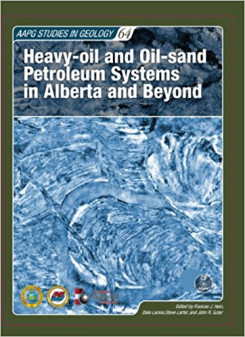Heavy-oil and Oil-sand Petroleum Systems in Alberta and Beyond
This volume showcases the geology of oil sands from around the world. It highlights the Athabasca Oil sands of northern Alberta and the geochemistry of the associated bitumen resource, but points directionally toward the development of other oil-sand deposits in the world. A novel feature is the 'case study' approach. Although much of the perspective is sedimentological and/or stratigraphic, the substance of the book should fine wide appeal to Earth scientists working in all geoscience domains.
The papers, from authors employed in the industry, academic researchers, and government scientists, provide new updates and insights into the regional geology, nuances of detailed depositional systems, reservoir modeling, and emerging sustainability issues. American Association of Petroleum Geologists (AAPG)
- Genre: All Books, Unconventional
Cast & Characters
| 1-22 | Heavy Oil and Bitumen Petroleum Systems in Alberta and Beyond: The Future Is Nonconventional and the Future Is Now |
| 23-102 | The Dynamic Interplay of Oil Mixing, Charge Timing, and Biodegradation in Forming the Alberta Oil Sands: Insights from Geologic Modeling and Biogeochemistry |
| 103-132 | Geologic Reservoir Characterization and Evaluation of the Petrocedeño Field, Early Miocene Oficina Formation, Orinoco Heavy Oil Belt, Venezuela |
| 133-144 | The Alberta Oil Sands: Reserves and Long-term Supply Outlook |
| 145-162 | Comparison of Oil Generation Kinetics Derived from Hydrous Pyrolysis and Rock-Eval in Four-Dimensional Models of the Western Canada Sedimentary Basin and Its Northern Alberta Oil Sands |
| 163-206 | Impact of Reservoir Heterogeneity and Geohistory on the Variability of Bitumen Properties and on the Distribution of Gas- and Water-saturated Zones in the Athabasca Oil Sands, Canada |
| 207-250 | A Regional Geologic Framework for the Athabasca Oil Sands, Northeastern Alberta, Canada |
| 251-272 | The Significance of Palynofloral Assemblages from the Lower Cretaceous McMurray Formation and Associated Strata, Surmont and Surrounding Areas in North-central Alberta |
| 273-312 | Stratigraphic Architecture of a Large-scale Point-bar Complex in the McMurray Formation: Syncrude’s Mildred Lake Mine, Alberta, Canada |
| 313-358 | Depositional Setting and Oil Sands Reservoir Characterization of Giant Longitudinal Sandbars at Ells River: Marginal Marine Facies of the McMurray Formation, Northern Alberta Basin, Canada |
| 359-372 | Advanced Seismic-stratigraphic Imaging of Depositional Elements in a Lower Cretaceous (Mannville) Heavy Oil Reservoir, West-central Saskatchewan, Canada |
| 373-406 | Oil-saturated Mississippian–Pennsylvanian Sandstones of South-central Kentucky |
| 407-436 | Overview of Heavy Oil, Seeps, and Oil (Tar) Sands, California |
| 437-480 | Unconventional Oil Resources of the Uinta Basin, Utah |
| 481-508 | Integrated Reservoir Description of the Ugnu Heavy Oil Accumulation, North Slope, Alaska |
| 509-530 | Overview of Natural Bitumen Fields of the Siberian Platform, Olenek Uplift, Eastern Siberia, Russia |
| 531-544 | Multiple-scale Geologic Models for Heavy Oil Reservoir Characterization |
| 545-564 | Modeling of a Tide-influenced Point-bar Heterogeneity Distribution and Impacts on Steam-assisted Gravity Drainage Production: Example from Steepbank River, McMurray Formation, Canada |
| 565-604 | Reservoir Modeling by Constraining Stochastic Simulation to Deterministically Interpreted Three-dimensional Geobodies: Case Study from Lower Cretaceous McMurray Formation, Long Lake Steam-assisted Gravity Drainage Project, Northeast Alberta, Canada |
| 605-624 | Spectral Decomposition in a Heavy Oil and Bitumen Sand Reservoir |
| 625-638 | Fundamentals of Heat Transport at the Edge of Steam Chambers in Cyclic Steam Stimulation and Steam-assisted Gravity Drainage |
| 639-654 | Integration of Steam-assisted Gravity Drainage Fundamentals with Reservoir Characterization to Optimize Production |
| 655-668 | Screening Criteria and Technology Sequencing for In-situ Viscous Oil Production |
| 669-688 | New Progress and Technological Challenges in the Integral Development of the Faja Petrolifera del Orinoco, Venezuela |
| 689-700 | Trading Water for Oil: Tailings Management and Water Use in Surface-mined Oil Sands |
| 701-724 | Potential Role of Microbial Biofilms in Oil Sands Tailings Management |
| 725-746 | Geothermal Energy as a Source of Heat for Oil Sands Processing in Northern Alberta, Canada |
| 747-777 | Joslyn Creek Steam-assisted Gravity Drainage: Geologic Considerations Related to a Surface Steam Release Incident, Athabasca Oil Sands Area, Northeastern Alberta, Canada |

